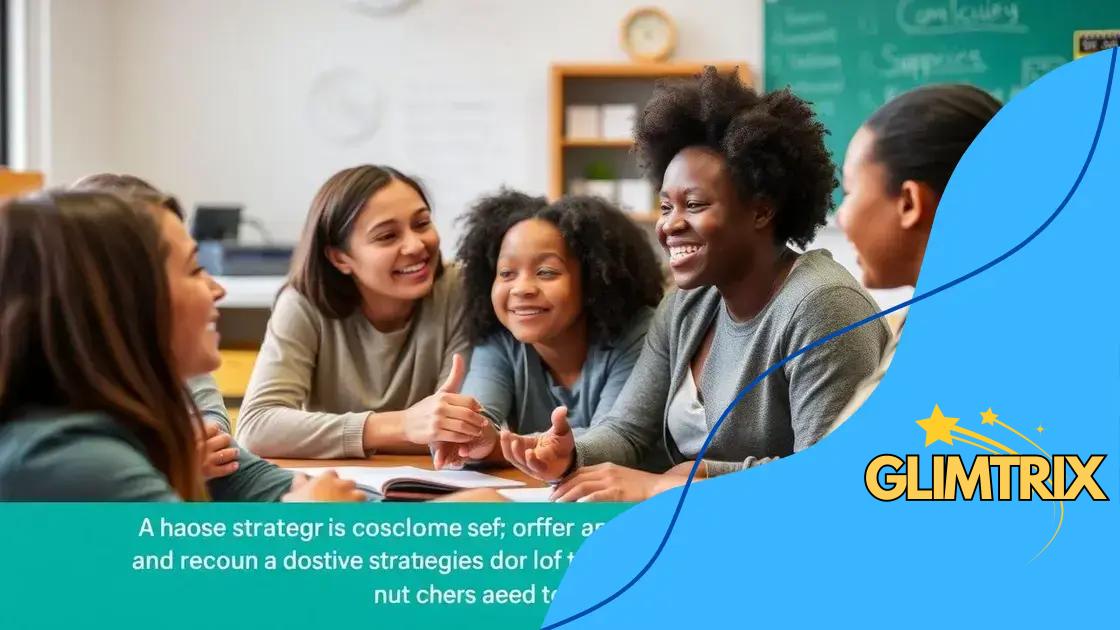Positive thinking and encouragement for school and college students

Building a supportive community for students enhances their academic success by fostering collaboration, providing emotional support, and promoting mentorship, which together create an environment where students thrive.
Positive thinking and encouragement for school and college students can truly reshape their experiences. Have you ever wondered how a supportive word or a simple smile can change someone’s day? Let’s dive into strategies that can uplift those around you.
Understanding the power of positive thinking
Understanding the power of positive thinking is essential for both school and college students. It helps them build resilience and face challenges with a positive outlook. Embracing this mindset can lead to better performance and overall happiness.
Benefits of Positive Thinking
When students adopt a positive attitude, several benefits unfold:
- Increased motivation and concentration.
- Improved relationships with peers and teachers.
- Higher levels of creativity and problem-solving skills.
These benefits can make a significant impact on academic success. The way students approach their studies and interact with others can change entirely when they focus on the positive side of things. It’s important to understand how thoughts shape emotions, and how these emotions influence behavior and decision-making.
How to Develop Positive Thinking
To cultivate a positive mindset, students can implement various strategies:
- Practice daily affirmations to boost self-esteem.
- Surround themselves with supportive friends.
- Engage in activities they love and excel at.
By consistently applying these strategies, students can reinforce their positive thinking habits. Additionally, setting small, achievable goals can contribute to a sense of accomplishment and optimism.
On the other hand, it is crucial to recognize and challenge negative thoughts. Students can question the validity of their negative beliefs and replace them with constructive thoughts. This can help in overcoming academic stress and anxiety, leading to a more positive student experience.
Ultimately, understanding the power of positive thinking is a journey. Students must be patient and persistent as they work to shift their mindset. The rewards of maintaining a positive attitude will not only enhance their academic journey but also enrich their lives in countless ways.
Strategies to foster encouragement among peers
Strategies to foster encouragement among peers can have a profound impact on the school and college environment. By supporting one another, students can cultivate a sense of community and belonging that enhances their learning experience.
Creating a Supportive Atmosphere
A supportive atmosphere is key to fostering encouragement. Here are a few strategies:
- Encourage open communication, where everyone feels safe to share their thoughts.
- Practice active listening, demonstrating that you value others’ opinions.
- Organize group activities that build trust and teamwork.
When students engage in group activities, they not only learn from each other but also appreciate diverse perspectives. This collaboration encourages a culture where positivity thrives.
Recognizing Achievements
Celebrating accomplishments, big or small, is essential to encouragement. Acknowledging peers for their hard work can boost morale and inspire further effort. Some ideas include:
- Creating a “Wall of Fame” in classrooms to showcase achievements.
- Implementing a peer recognition program where students nominate each other.
- Holding monthly awards ceremonies for academic and personal achievements.
When students see their efforts appreciated, it motivates them to pursue excellence. Reinforcing positive behaviors helps create a cycle of encouragement, where students uplift one another.
Additionally, offering words of encouragement in challenging times can make a significant difference. Simple phrases like “You’ve got this!” or “I believe in you!” can empower peers during stressful situations. This small act of kindness can build their confidence and reinforce a positive mindset.
Encouragement is not just about words; it’s also about actions. Students can support their peers by offering study sessions or collaborating on projects. When they work together, they can share strengths and overcome struggles collectively. This unity helps everyone feel valued and connected, contributing to a vibrant school culture.
How to overcome negativity in academic settings

Overcoming negativity in academic settings is vital for the well-being of students. Negative thoughts and feelings can hinder performance and damage self-esteem. Thankfully, several strategies can help students turn negative experiences into positive outcomes.
Identifying Negative Thoughts
The first step to conquering negativity is recognizing and identifying negative thoughts. Students should pay attention to their inner dialogue and be aware of self-defeating phrases. Instead of saying, “I can’t do this,” try replacing it with, “I will do my best and learn from mistakes.” This simple shift can foster a more positive thinking environment.
Challenging Negative Beliefs
Once negative thoughts are identified, students can challenge these beliefs. They can ask themselves questions like:
- Is this thought true?
- What evidence do I have to support it?
- How would I advise a friend in this situation?
By analyzing these thoughts, students can gain clarity and see situations from a different, more optimistic perspective. This process is crucial for fostering a more supportive learning environment.
Another important aspect is practicing mindfulness. Mindfulness techniques, such as meditation and focused breathing, can help students manage stress and remain grounded. When students practice being present, they are less likely to dwell on past failures or future worries, thus promoting a more positive academic mindset.
Building Resilience
Resilience plays a key role in overcoming negativity. Resilient students can bounce back from setbacks and maintain a positive outlook. Some effective ways to build resilience include:
- Setting realistic goals and celebrating small achievements.
- Developing problem-solving skills to address challenges.
- Finding supportive peers to share experiences and encourage one another.
Through these strategies, students can create an environment where negativity is minimized. It’s important to remember that everyone faces challenges, but with the right tools and mindset, students can rise above them.
In addition to these strategies, seeking help from teachers, counselors, or mental health resources is crucial. Support systems can provide guidance and reassurance. Students should not hesitate to reach out and express their feelings, as opening up about struggles is a significant step towards overcoming them.
The role of mentors in student success
The role of mentors in student success cannot be overstated. Mentors provide guidance, support, and encouragement which can significantly enhance a student’s academic journey. Having someone to turn to for advice creates a sense of connection and helps students navigate challenges more effectively.
Building Confidence and Skills
One of the primary roles of a mentor is to help students build confidence. Through regular interactions, mentors can empower students to believe in their abilities and encourage them to take risks. This support helps cultivate essential skills, such as:
- Effective communication and interpersonal skills.
- Problem-solving and critical thinking.
- Time management and organization techniques.
As students develop these skills, they gain a greater sense of control over their academic lives, which is often crucial for success.
Providing Emotional Support
Mentors also play a critical role in providing emotional support. School and college can be stressful, and having someone to talk to about worries and fears can make a significant difference. Mentors can help students:
- Manage stress and anxiety related to academic pressures.
- Set realistic goals and maintain a positive mindset.
- Develop strategies to overcome self-doubt.
Through these interactions, students feel less isolated and more motivated to overcome obstacles, enhancing their overall well-being.
Importantly, mentors can also help students explore career paths and educational opportunities. By sharing their experiences, mentors can offer valuable insights that shape a student’s future decisions. They might help students discover new interests or clarify their aspirations. This guidance can be especially beneficial during pivotal moments, such as choosing a major or applying for internships.
Encouragement from mentors inspires students to pursue their passions and work hard toward their goals, reinforcing a cycle of success. As students experience progress, their confidence grows, leading to even greater achievements.
Through consistent support and engagement, mentors can create lasting impacts on their mentees. This relationship not only fosters academic success but also prepares students for life beyond the classroom by instilling essential values like resilience, responsibility, and dedication.
Building a supportive community for students
Building a supportive community for students is essential for their overall success and well-being. A strong community provides students with the encouragement they need to thrive in academic environments. When students feel supported, they are more likely to engage and reach their full potential.
Encouraging Collaboration
One key aspect of a supportive community is fostering collaboration among students. Group projects and study sessions can promote teamwork and help students learn from each other. To encourage collaboration:
- Create study groups that meet regularly to review materials together.
- Encourage peer tutoring programs where students can help each other.
- Organize team-building activities that enhance social connections.
These efforts not only build relationships but also boost confidence and academic performance.
Creating Safe Spaces
Another important factor is creating safe spaces where students feel comfortable expressing themselves. This includes:
- Establishing clubs and organizations that reflect diverse interests and backgrounds.
- Implementing open forums for students to discuss issues affecting them.
- Encouraging positive communication that respects everyone’s opinions.
In these safe environments, students can be themselves without fear of judgment. This inclusivity fosters a sense of belonging that is crucial for mental health.
Additionally, having mentors and faculty who are approachable and supportive contributes greatly to building community. When students know they have someone to turn to, they feel more connected and engaged in their academic journeys. Mentorship programs can bridge the gap between students and staff, fostering relationships that extend beyond the classroom.
Moreover, organizing community service projects can unite students toward a common goal. Volunteering helps build camaraderie while giving back to the community. It allows students to develop empathy and a sense of purpose, reinforcing the community bond.
Finally, celebrating achievements—both big and small—can strengthen community ties. Recognizing student accomplishments through award ceremonies or shout-outs in newsletters creates a culture of appreciation. When students celebrate each other, they fuel motivation and encourage continued effort.
FAQ – Frequently Asked Questions about Building a Supportive Community for Students
Why is a supportive community important for students?
A supportive community boosts students’ confidence, enhances their engagement, and promotes academic success.
How can collaboration be encouraged among students?
Collaboration can be fostered through group projects, study sessions, and team-building activities.
What role do mentors play in student success?
Mentors provide guidance, emotional support, and encouragement, helping students navigate challenges and achieve their goals.
How can achievements be recognized within the community?
Recognizing achievements can be done through awards, newsletters, and shout-outs, creating an environment of appreciation.





